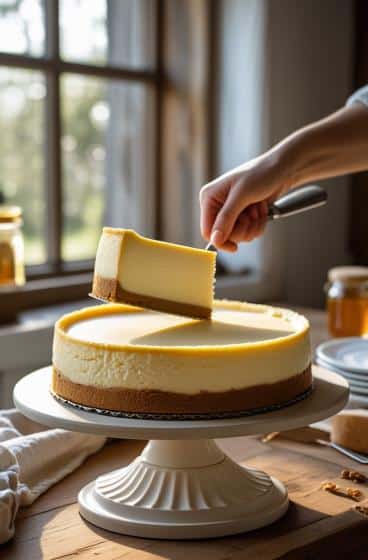Ever wondered why cheesecake feels like a little slice of heaven on earth? That creamy, velvety texture paired with a buttery crust—it’s magic. But making one at home? Some folks shy away, thinking it’s complicated or finicky. Truth is, with the right technique and ingredients, you can whip up an easy homemade cheesecake that rivals bakery masterpieces. This isn’t just any cheesecake; it’s a soulful, timeless dessert that’s endlessly adaptable and deeply satisfying. Let’s dive in and uncover the secrets to perfecting this classic treat.
What Makes This Easy Homemade Cheesecake Recipe Special?
Cheesecake’s roots stretch back thousands of years, tracing to ancient Greece, but the modern creamy, dense, yet smooth version owes much to American culinary innovation. This recipe is all about simplicity without sacrificing depth of flavor. It uses straightforward ingredients but with a few chef’s tricks that guarantee a silky finish and crack-free top. Instead of fancy flavorings or elaborate decorations, it focuses on the fundamentals: texture, balance, and that little je ne sais quoi only a homemade cheesecake can deliver.
A key highlight? The way we handle the cream cheese and baking method ensures that luscious creaminess without the dreaded cracks. Plus, it’s flexible—you can easily jazz it up with berries, chocolate, or citrus, or keep it pure and elegant. This cheesecake isn’t just a dessert; it’s a canvas for your creativity, a testament to how simple ingredients can yield extraordinary results.
Ingredients & Substitutions
| Ingredient | Measurement | Purpose | Substitutions | Notes on Selection |
|---|---|---|---|---|
| Cream Cheese | 2 blocks (8 oz each) | Base, creamy texture | Neufchâtel (lower fat), Vegan cream cheese | Use room temp for smooth blending; avoid low-fat versions for best richness |
| Granulated Sugar | 3/4 cup | Sweetness | Coconut sugar, Stevia (adjust quantity) | Regular sugar caramelizes well; natural sweeteners may affect texture |
| Graham Crackers | 1 1/2 cups (crumbs) | Crust | Digestive biscuits, Oreos, Gluten-free cookies | Crush finely for even crust; buttery crumbs hold together best |
| Unsalted Butter | 1/4 cup (melted) | Crust binder | Coconut oil, Margarine | Butter adds flavor and richness; melted for easy mixing |
| Eggs | 3 large | Structure, binding | Flax eggs (1 tbsp flax + 3 tbsp water each), Aquafaba | Use room temp eggs for smoother texture; flax or aquafaba for vegan options |
| Sour Cream | 1 cup | Moisture, tang | Greek yogurt, Coconut cream | Full-fat sour cream yields best texture; avoid watery substitutes |
| Vanilla Extract | 2 tsp | Flavor enhancer | Almond extract, Citrus zest | Pure vanilla extract gives the classic cheesecake aroma |
| Lemon Juice/Zest (optional) | 1 tbsp juice + 1 tsp zest | Brightness | Orange zest, Lime zest | Fresh zest adds lively aroma; juice balances sweetness |
Ingredient Selection Insights
Cream cheese should be full-fat and softened at room temperature to blend seamlessly, avoiding lumps. Granulated sugar works best here for balanced sweetness and texture. For the crust, the graham cracker’s subtle honeyed notes complement the filling perfectly, but digestive biscuits offer a nuttier, less sweet base. Butter binds the crust crumbs and adds a toasty flavor when baked. Sour cream or Greek yogurt adds moisture and a subtle tang, cutting through the richness for balance.
Step-by-Step Instructions
1. Prepare the Crust
Start by preheating your oven to 325°F (160°C). Mix finely crushed graham crackers with melted butter and a touch of sugar. Press this mixture firmly into the bottom of your springform pan. Using the bottom of a glass helps compact it evenly. Bake for about 10 minutes until lightly golden. This step sets a crisp, buttery base that won’t get soggy.
Pro tip: Don’t skip pre-baking the crust; it locks in flavor and keeps it from soaking up moisture from the filling.
2. Make the Cheesecake Filling
Beat softened cream cheese with sugar until smooth and creamy. Use a hand mixer or stand mixer on low speed to avoid overwhipping, which can incorporate too much air and cause cracks. Add eggs one at a time, blending gently after each. Incorporate sour cream and vanilla extract, mixing just until combined.
Common mistake: Overmixing. It creates air bubbles that lead to cracks during baking.
3. Pour and Bake
Pour the filling over the pre-baked crust and smooth the surface with a spatula. Place the springform pan inside a larger baking dish. Add hot water to the outer dish to create a water bath (bain-marie). This gentle moisture prevents sudden temperature changes, ensuring a creamy texture.
Bake at 325°F (160°C) for about 50-60 minutes, until the edges are set but the center still slightly jiggles when you shake the pan.
Pro tip: Resist the urge to open the oven door frequently; sudden temp drops cause cracks.
4. Cooling and Chilling
Turn off the oven, crack the door open, and let the cheesecake cool slowly inside for about an hour. Then, chill it in the fridge for at least 4 hours or overnight. This resting period allows flavors to meld and texture to firm up perfectly.
Variations
- For a fruit swirl, gently fold in pureed berries before baking.
- Add a teaspoon of espresso powder for a mocha twist.
- Swap vanilla for almond extract or lemon zest for brightness.
Cooking Techniques & Science
Why a Water Bath?
The bain-marie bath is a chef’s secret weapon against cracks. Cheesecake is essentially a delicate custard. Without gentle, even heat, it contracts unevenly and cracks. The water bath insulates and provides humidity, preventing drying and rapid cooling.
The Role of Eggs and Fat
Eggs coagulate proteins during baking, setting the cheesecake’s structure. But too much or overcooked eggs make it rubbery. Cream cheese and sour cream add fat and moisture, keeping it smooth and rich. Balancing these is key.
Temperature & Mixing Science
Room temperature ingredients mix more evenly. Cold cream cheese creates lumps, while overmixing whips in air bubbles causing cracks. A low mixing speed minimizes this.
Storage & Reheating
Cheesecake keeps best refrigerated, tightly wrapped, for up to 5 days. Freeze for up to 2 months—thaw overnight in the fridge. Reheat slices gently in a warm oven or microwave on low if desired, but it’s best served cold or room temp.
Tools That Matter
A springform pan is essential for easy removal without damaging the delicate edges. A hand or stand mixer with paddle attachment helps mix evenly without excess air. A baking dish for the water bath is a game changer for perfect texture.
Serving & Pairing Suggestions
Presentation elevates cheesecake. Dust with powdered sugar, or brush the crust edges with melted chocolate for a touch of elegance. Top with fresh berries, a drizzle of caramel or fruit coulis, or even a spoonful of homemade whipped cream.
Pair this creamy dessert with:
- A cup of rich espresso or black coffee to balance sweetness.
- A glass of late-harvest Riesling or Moscato for fruity contrast.
- Fresh fruit salad or tart compote to cut richness.
For festive occasions, add a sprinkle of toasted nuts or edible flowers.
Best Time to Serve or Eat This Dish
Cheesecake shines as a dessert after dinner, especially for celebratory meals or holidays. Its richness means smaller portions satisfy deeply. It also works beautifully for brunches or afternoon teas paired with fruit and light beverages. Ideally, serve chilled but take out 15-20 minutes before eating for optimal texture and flavor.
Conclusion
This easy homemade cheesecake recipe marries simplicity with chef-level technique, ensuring a luscious, crack-free, perfectly creamy dessert every time. By focusing on ingredient quality, gentle mixing, and baking in a water bath, you avoid common pitfalls that intimidate many home bakers. Plus, it’s incredibly versatile—you can keep it pure or tailor it with your favorite flavors.
Remember to use full-fat cream cheese and room temperature ingredients for smoothness. Don’t rush cooling; patience rewards you with the ideal texture. A good crust sets the stage, and the water bath guarantees a silky finish.
Try variations with seasonal fruits, zesty citrus, or even chocolate swirls. With these expert tips, you’ll never hesitate to make cheesecake at home again.
Frequently Asked Questions (FAQs)
Q1: How do I prevent cracks on my cheesecake?
Cracks come from overmixing, overbaking, or rapid temperature changes. Use a water bath, mix on low speed, avoid opening the oven door early, and cool the cheesecake slowly in the oven before chilling.
Q2: Can I use a regular cake pan instead of a springform pan?
You can, but springform pans make it easier to remove the delicate cheesecake without damaging the sides. If using a regular pan, line with parchment paper and be extra careful when unmolding.
Q3: How long does homemade cheesecake last?
Store refrigerated in an airtight container for up to 5 days. It can also be frozen for up to 2 months. Always thaw in the refrigerator overnight.
Q4: Can I make this cheesecake vegan or gluten-free?
Yes. Use vegan cream cheese alternatives, flax eggs instead of regular eggs, and gluten-free cookie crumbs for the crust. Expect some differences in texture but still delicious.
Q5: Why is my cheesecake grainy?
Graininess usually happens if cream cheese wasn’t fully softened or if you overbake. Mix until smooth and bake until just set but still slightly jiggly in the center.
Making cheesecake at home doesn’t have to be intimidating. With this recipe and these insights, you’re armed to impress yourself and your guests with a luscious, creamy, perfectly baked cheesecake that tastes like a dream. So preheat that oven and let’s get baking—because no one should have to wait for a special occasion to enjoy the best cheesecake ever.
C

